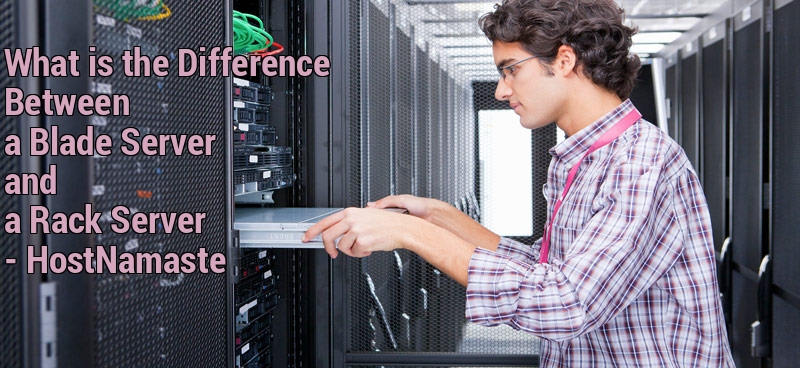
What is the Difference between a Blade Server and a Rack Server – HostNamaste
Both Blade servers and rack servers are two different types of server hardware architectures that are used to provide computational resources for enterprise applications. The major differences between blade servers and rack servers are:
1) Physical Design:

Blade servers are typically designed as a single circuit board that contains all of the necessary hardware components, including processors, memory, storage, and network interfaces. Multiple blade servers can be inserted into a chassis that provides power, cooling, and connectivity, creating a highly dense and modular architecture.

Rack servers, on the other hand, are standalone servers that are housed in a rack-mounted enclosure. Rack servers typically have a larger form factor than blade servers and can be customized with different configurations of hardware components.
2) Scalability:
Blade servers are highly scalable and modular, allowing organizations to easily add or remove blades as needed to meet changing computational requirements. This makes blade servers a popular choice for data centers that need to scale their infrastructure quickly and efficiently.
Rack servers are also scalable but typically require more physical space and power than blade servers to add additional units.
3) Management:
Blade servers are designed to be highly manageable, with centralized management tools that allow administrators to monitor and control the entire blade server infrastructure from a single console. This makes it easier to manage and troubleshoot issues that may arise with multiple blade servers.
Rack servers, while also manageable, may require more manual intervention and monitoring, especially if they are spread across multiple racks or locations.
4) Cost:
Blade servers can be more expensive than rack servers due to the need for a separate chassis and power infrastructure. However, the modular design of blade servers can provide cost savings in the long run by allowing organizations to add or remove blades as needed without having to purchase additional infrastructure.
Rack servers are typically less expensive than blade servers, but may require additional investment in physical space, power, and cooling infrastructure as the server fleet grows.
5) Power and Cooling:
Blade servers typically consume less power and require less cooling than traditional rack servers, which can be a significant cost savings for large-scale data center deployments. This is because blade servers are designed to share power and cooling infrastructure within the chassis, rather than relying on individual power and cooling for each server.
Rack servers, on the other hand, require more power and cooling infrastructure, which can increase their operating costs over time.
6) Density:
Blade servers are designed for high-density deployments, allowing organizations to pack a large number of servers into a small space. This can be especially useful for data centers that have limited physical space or need to reduce their overall footprint.
Rack servers, while still relatively dense, typically require more space than blade servers due to their larger form factor.
7) Customization:
Blade servers are often designed to be highly customizable, with a variety of hardware options available for different use cases. This can allow organizations to create bespoke blade server configurations that are optimized for specific workloads or applications.
Rack servers, while still customizable, may have fewer hardware options available and may be less flexible in terms of customizations.
Also Read: What is a Virtual Dedicated Server – VDS – Virtual Dedicated Servers
8) Maintenance and Upgrades:
Rack servers, while still relatively easy to maintain and upgrade, may require more downtime and manual intervention to perform maintenance or upgrades, especially if they are spread across multiple racks or locations.
9) Performance:
Blade servers can offer excellent performance for certain workloads, especially those that require a high degree of parallel processing or require a large number of virtual machines. This is because blade servers can provide a high degree of computational density within a small space, allowing organizations to maximize the use of their available resources.
Rack servers, while still capable of excellent performance, may not be able to match the computational density of blade servers, especially for large-scale deployments.
10) Security:
Blade servers can be more secure than rack servers, especially when deployed in a secure data center environment. This is because blade servers can be physically secured within the chassis, making them more difficult to access or tamper with.
Rack servers, while still secure, may require additional physical security measures to ensure that they are protected from unauthorized access or tampering.
Conclusion
Blade servers and rack servers have different strengths and weaknesses that make them suitable for different types of deployments. Blade servers are highly scalable, modular, and manageable, making them ideal for large-scale data center deployments where space, power, and cooling are at a premium. Rack servers are more traditional, standalone servers that offer flexibility and customization options, making them ideal for smaller deployments or for organizations that need to create bespoke server configurations for specific applications.
In summary, the choice between blade servers and rack servers will depend on an organization’s specific requirements for scalability, manageability, cost, performance, and security. Both types of servers have their strengths and weaknesses, and organizations will need to carefully evaluate their needs before selecting the appropriate hardware architecture for their applications.


